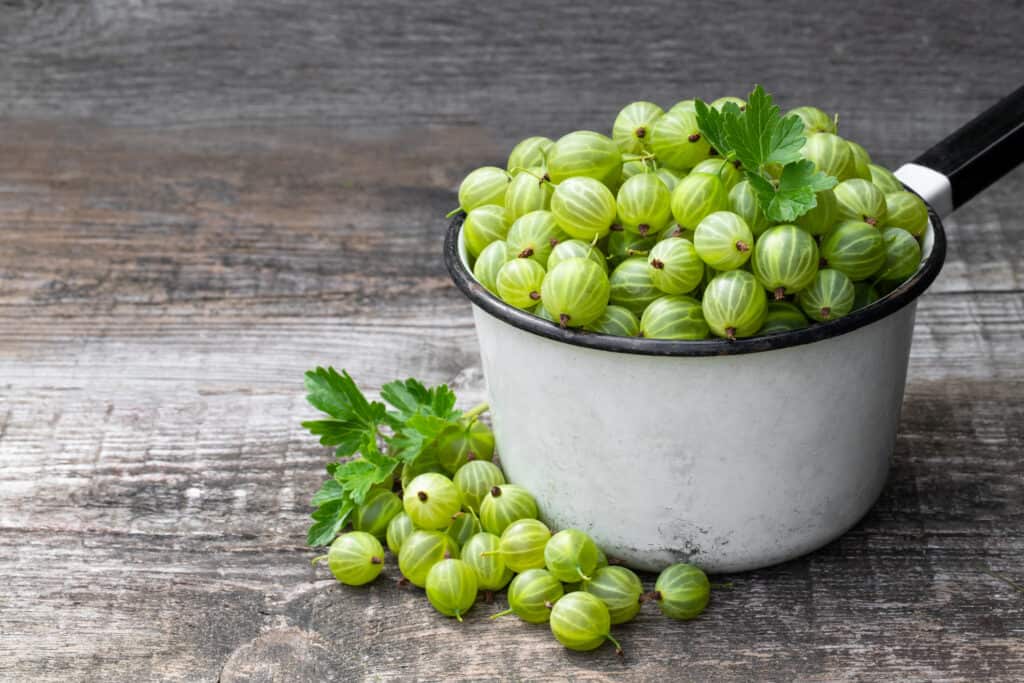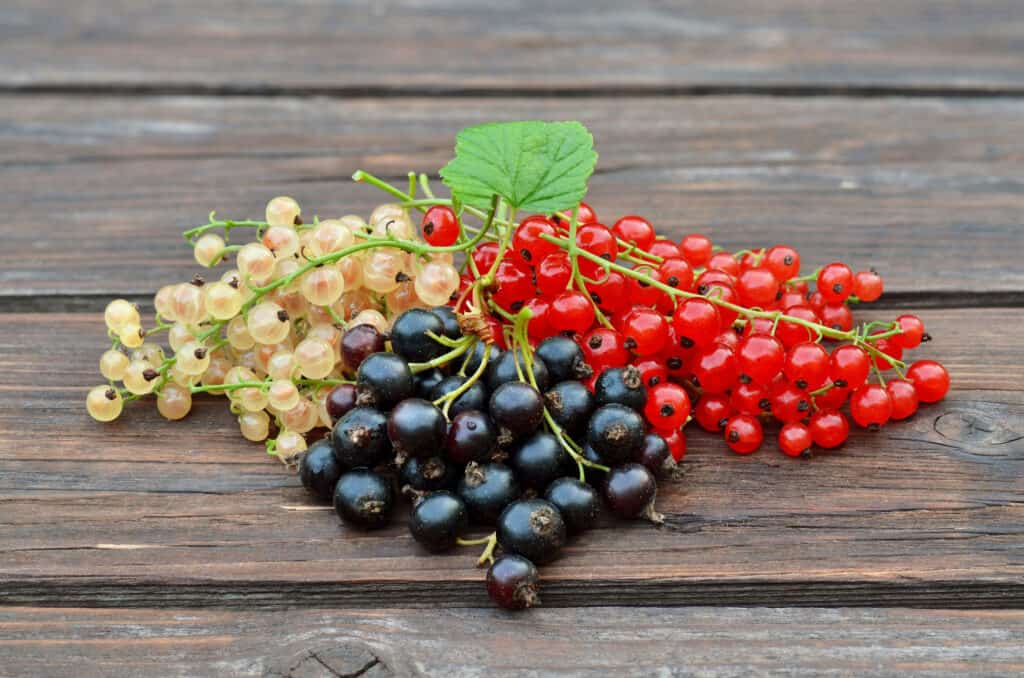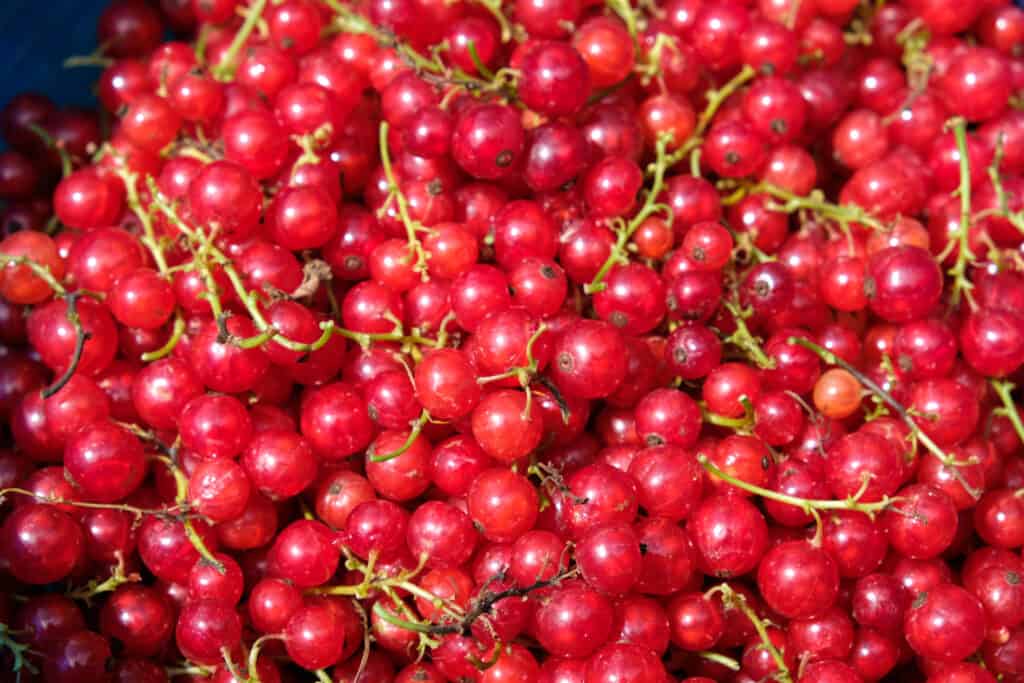Currants and gooseberries share an interesting relationship. First, while both are shrubs that produce small berries, the flavor, color, and vegetation are different. It is also important to note that gooseberries and currants are common names for multiple different species and varieties. They also both belong to the Ribes genus.
Despite their similarities, there are more differences. These differences can help us understand how to tell them apart. Keep reading to find out the differences between gooseberries and currants.
Comparing Gooseberry vs. Currant
| Gooseberry | Currant | |
|---|---|---|
| Scientific Classification | Ribes. Scientific Name: Ribes uva-crispa. | Ribes. Scientific Name: Currant |
| Description | Gooseberries are small spiny shrubs with green and pink flowers. The fruits are oval, edible, and have small hairs on the surface. It has 3 or 5 lobed leaves and grows up to 5 feet tall. | Currants are spreading bushes with short and long stems, resembling small trees. The leaves depend on the species but are typically round. Berries grow in clusters and are usually red and blue/black. |
| Uses | Gooseberries are used when making jams and sauces. You can also make a puree. | Red and black currants are popularly used in desserts, jams, jellies, and lozenges. |
| Origin and Growing Preferences | These hardy plants grow in the Northern Hemisphere, including the United States, India, and the Arctic Circle. They grow in USDA zones 3-8. | Currants naturally grow in Northern Europe and Northern Asia, but they are hardy in North America. They grow in USDA zones 3-8. |
| Flavor and Taste | They can be sour and slightly sweet, almost like an unripe grape. | They are sweet and sour, often compared to cherries, strawberries, and grapes. |
Key Differences Between Gooseberry vs. Currant
It can be difficult to understand the differences between gooseberries and currants since they are very similar and belong to the same genus. However, whether you want to grow these plants or you are trying to understand the differences, it is a good idea to look at the classification, description, uses, origin and growing preferences, and flavor and taste.
Gooseberry vs. Currant: Classification

The scientific name for gooseberry is
Ribes uva-crispa.
©iStock.com/Lena_Zajchikova
Gooseberries and currants are fruits from the same genus, Ribes. Since they are not the same plants, the fruits have different scientific names. The scientific name for gooseberry is ribes uva-crispa, while for currant, it is currant. There are two general types of gooseberries, American and European. There are a lot more currants varying in colors.
Gooseberry vs. Currant: Description

Currants have smooth stems and are typically red, purple, or blue.
©iStock.com/Yuliia Bilousova
Currants and gooseberries are often confused for one another. They have a similar appearance, being small round berries with slightly leathery skin. However, the biggest difference in appearance between both plants is that gooseberries have long and sharp spines. They are bushier and grow in clusters of three or four. The flowers are either green or pink. Currants, on the other hand, have smooth stems and are typically red, purple, or blue. They have long stems with small hairs. The stems produce dozens of flowers, which makes bright red currants look a lot like bunches of hanging cherries.
Gooseberry vs. Currant: Uses
Both of these fruits are often dried or cooked in many dishes. They have a similar flavor, which is perfect for highly seasoned dishes and red meats. For example, you can use gooseberries and currants to make an acidic and sweet sauce for sandwiches and steak. They are also common ingredients in jams and jellies. Currants are usually dried and eaten like raisins. Like most fresh and natural fruits, gooseberries and currants have plenty of health benefits, although no studies indefinitely state this. Gooseberries are made into a puree to help with diarrhea and other digestive health issues in some Asian counties, including India. They are high in vitamin C and E. Black currants are also added to medications, including lozenges.
Gooseberry vs. Currant: Origin and Growing Preferences

Currants are from temperate parts of central and northern Europe and northern Asia.
©iStock.com/Phreedle
Even though gooseberries and currants have similar appearances, they are not from the same location. Gooseberries originate from some parts of North America, India, and as far north as the Arctic Circle. They are hardy plants but require plenty of warmth and sunlight. The best USDA zones to grow them are 3 to 8. Too much sunlight can cause wilting.
Unlike gooseberries, currants are from temperate parts of central and northern Europe and northern Asia. While they originate from these two continents, they are mainly grown in North America. They grow quickly but usually don’t produce flowers or fruit for up to 3 years after being planted. They excel in USDA zones 3 to 8.
Gooseberry vs. Currant: Flavor and Taste
So, what do these unique fruits taste like? Gooseberries are sweet but also tart. They almost taste like citrus and are typically made into bitter-sweet jams for this reason. Currants, though, are sweet and sour but not citrusy. They are commonly compared to cherries and baked into pies.
Up Next:
- Gooseberry vs. Goldenberry: Is There a Difference?
- Bilberries vs. Blueberries: What’s the Difference?
- Chokecherry vs. Chokeberry: Is There a Difference?
The photo featured at the top of this post is ©
Thank you for reading! Have some feedback for us? Contact the AZ Animals editorial team.






